The Crochet Coral Reef
Air Date: Week of February 16, 2024
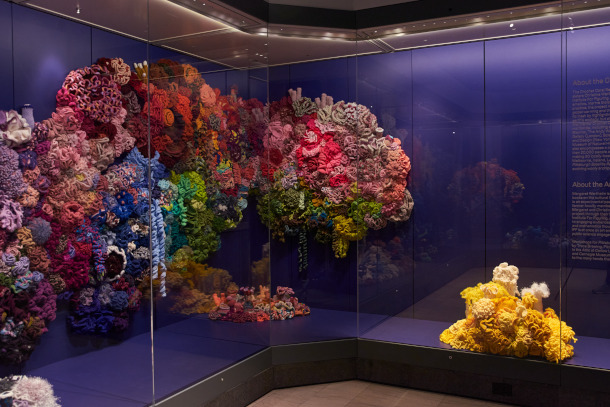
Alyssa Velazquez, the curator at the Carnegie Museum of Art, organized the Pittsburgh Satellite Reef by color to mimic the way water filters visible light. (Photo: Sean Eaton, Courtesy of Carnegie Museum of Art)
To raise awareness about the threats facing coral reefs, crafters everywhere are picking up their crochet hooks and contributing to a worldwide “Crochet Coral Reef.” Host Paloma Beltran spoke with Alyssa Velazquez, the curator of the Pittsburgh Satellite Reef at the Carnegie Museum of Art about what it’s like to stand inside the exhibit and how it came together.
Transcript
CURWOOD: It’s Living on Earth, I’m Steve Curwood.
BELTRAN: And I’m Paloma Beltran.
Coral reefs are in trouble. The upper layers of the oceans absorb most of the warming and around a third of the carbon dioxide emissions from the climate crisis, making the water hotter and more acidic. These conditions are leading to coral bleaching and making it harder for corals to grow. Back in 2005, sisters Christine and Margaret Wertheim, founders of the Institute for Figuring, learned about the threats facing coral reefs. And they felt inspired to pick up their crochet hooks. They got to work making corals of all different shapes and colors, and with the help of many other crafters and museums their project has grown into a worldwide Crochet Coral Reef with around 50 “satellite reefs.” One of those is on display until 2025 at The Carnegie Museum of Art in Pittsburgh, Pennsylvania. The project brought crochet workshops to diverse communities around Pittsburgh and collected contributions from nearly 300 crafters. Here to talk to us about the project is Alyssa Velazquez, who led the Pittsburgh Satellite Reef as a curator at the Carnegie Museum of Art. Hi Alyssa, and welcome to the show!
VELAZQUEZ: Thank you. I'm so excited to be here.
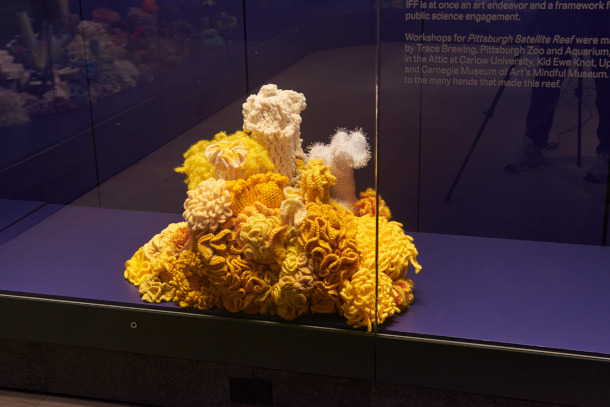
The Pittsburgh Satellite Reef combines layered “frilly cabbage leaves” with cylindrical structures to mimic actual coral reefs. (Photo: Sean Eaton, Courtesy of Carnegie Museum of Art)
BELTRAN: We're really happy to have you. So if someone was walking through the Pittsburgh Satellite Reef exhibit, what would they see?
VELAZQUEZ: The Pittsburgh Satellite Reef is on the second floor of our hall of sculpture along the balcony with this decorative iron railing that visitors can walk around to view the marble sculptures. There's this little U-shaped gallery. If you enter the gallery, you travel along a curved and glassed-in display case. If you ever been to an aquarium, you might recall a similar space with low lighting and almost floor-to-ceiling glass panels in front of you. And so behind that glass is a large-scale wooly archipelago, chromatically organized to represent how colors filter through water. In other words, as light passes through a great distance of water, color is selectively absorbed by the water. So for the installation, all the hot or warm colors, those pinks, those reds, those yellows are at the top. And as your eye moves down the 2D wall pieces and rests on the floor of the case to roam over the 3D coral sculptures, you're left with blues, and purples, and greens. So they're all growing out of the space that's painted a rich plum, purple color to better offset the multicolored yarn. And to create the illusion that a coral colony found its way out of the Gulf of Mexico through the Mississippi, converged as a group along the Ohio, swam the Allegheny or the Monongahela River, depending on which one they wanted to swim, and they just started growing in our galleries for our visitors near and far. Which was one of the reasons why we felt the Carnegie Museum of Art was a great fit for this project in a city known for those three rivers, Ohio, Allegheny, Monongahela, and those waterways have a trickle effect, literally and pardon the pun, but on the ocean acidification and coral health.
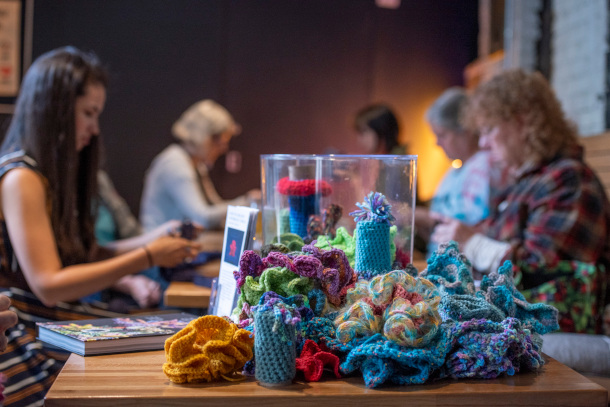
The Carnegie Museum of Art brought together 281 artists to make the Pittsburgh Satellite Reef. (Photo: Sean Eaton, Courtesy of Carnegie Museum of Art)
BELTRAN: Sounds absolutely beautiful. You know, coral reefs are often referred to as the rainforest of the sea. They can be huge, and they support approximately 25% of all marine species. As a curator, how did you try and convey the grandiosity of this diverse ecosystem?
VELAZQUEZ: As a curator, I knew that for the piece itself to really shine, we needed to get inventive with our display strategies. And one of the things that was working in our favor was the space itself, the fact that it was a boxed-in aquarium just waiting to be filled with specimen-like objects. I started looking at lots of pictures of home aquariums, as well as public aquariums. And they all have somewhat of a purple, blue, green tinge to them, which is where we came up with the background color. And then within the coral pieces that we started receiving from community members, wanting them to dictate a lot of the design. And so when thinking of 2D elements that we would mount on the wall, that was because a lot of the corals that were being generated in these workshops were flat, or what I would lovingly term frilly cabbage leaves. Then so those have more presence when you're able to lay them down and build on top of each other, and how much more presence would they have, if you lay them down, build them on top of each other, and then turn them upright and mount them on a wall. And so then you create a 3D effect that's coming directly at you from the back of the case, reaching out to the glass and in some cases, to give greater that effect of rogue corals growing in the space, some of the corals touch the glass. And that was really important for us to create it. And then in addition to those 2D elements, having 3D sculptures on the ground, so that you have a diversity of visitors that can come in from various ages, and that there is something on everyone's eye level to really catch their intrigue, and make them look in amazement at where they are, both like literally and physically within the space.
BELTRAN: So also the little people could see the exhibit and live it.
VELAZQUEZ: Yes.
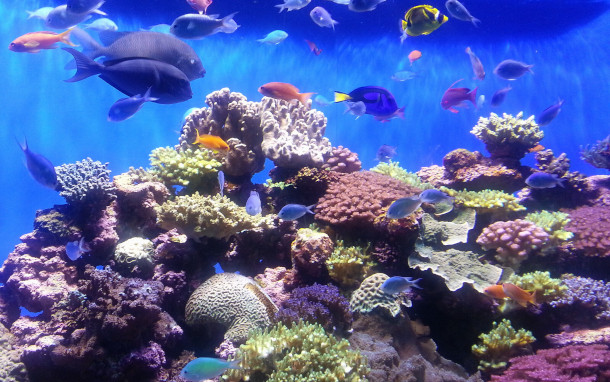
Coral reefs around the world are threatened by the climate crisis and plastic pollution. (Photo: bryceguy72, DeviantArt, CC BY-NC-ND 3.0)
BELTRAN: It sounds like there's such a variety of different forms in this exhibit. Like layered cabbage leaves.
VELAZQUEZ: Right, so for the cabbage-leaf-shaped, what they call hyperbolic planes or the hyperbolic corals that are flat, we layered them on top of each other, or in some cases, to create dimensionality, especially on the 2D wall sculptures, I would condense them, you could say almost in a tulip-like shape, and then would stuff them into various crevices to create a sense of growing out of and blooming. So there were some more three-dimensional shapes. If you think of tubers that are very iconic of coral formations on ocean floors, those sometimes were given additional rigidity with cardboard, or we did fill them with the stuffing that are in teddy bears.
BELTRAN: What types of materials did people use to make these corals?
VELAZQUEZ: The material used to make the corals are varied. They are from simple weighted thread, to cassette tapes, to VHS's, to water bottles, to wire. It all depended on the crocheter's comfortability with a hook. And so if you look at the coral reef, you'll see some shiny bits, and that might be a little bit of a reflective cassette tape. Or you'll see some sparkly bits, and that might be a unique type of yarn that's very delicate and thin and has some metallic elements. Or you might see some really warm, earthy greens and reds, and that's coming from some basic medium-weighted yarns for beginners.
BELTRAN: So I have yet to live the exhibit, but I've been told that it includes acrylic nails, what is the significance of that?
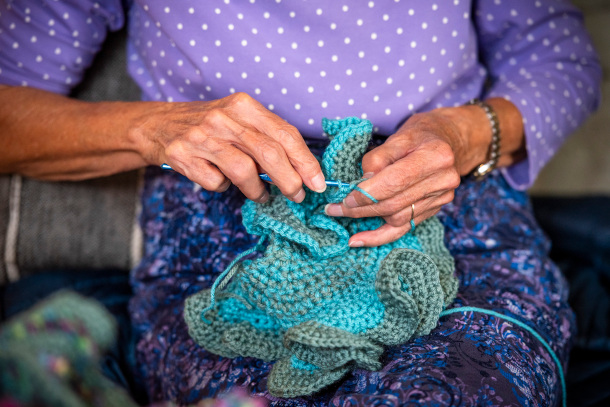
The Pittsburgh Satellite Reef brought together people from across the generations to work on a unique crochet project. (Photo: Sean Eaton, Courtesy of Carnegie Museum of Art)
VELAZQUEZ: Yes, so as the exhibition space, I described that U-shaped gallery, that's the primary space that we display the coral reef, but we also within that hall of sculpture off of the balcony, one of the ways of accessing that gallery space is by a staircase. And when you're going up the staircase, on that second floor, there's a little niche with glass covering over it. And for that niche, we wanted to put some corals in. And I saw that we were developing an exhibition design that was very bombastic in the main exhibition space. And for this small case, I really wanted to explore some of the stereotypes from contemporary art museums, one of them being the white cube. So rather than painting it purple, like the main exhibition space, we left it white. And rather than filling it with as many corals as possible, I selected two corals. And so I created a space in which you could have a small coral and a large branch coral within a white box. And on the floor of this white box, where these corals seem to be growing out of, is a bed of white acrylic nails. As a material, they're plastic. A lot of the acidification in the oceans is due to our single-use and non-degradable plastic waste, but also this discussion about primarily the makers of the Pittsburgh Satellite Reef, but also most of the satellite reefs, part of the Worldwide Crochet Project.
BELTRAN: Why is having art that relates to the environment so important?
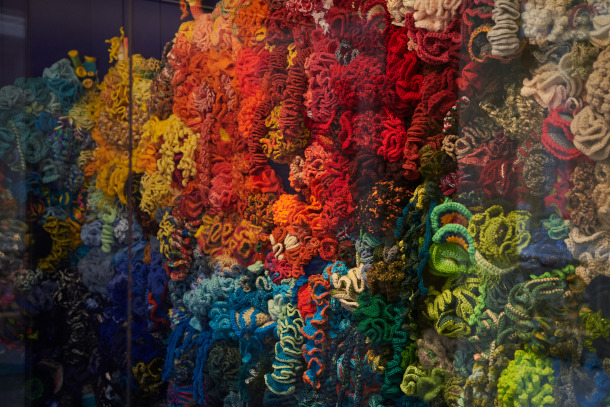
Velazquez created the feeling that the corals are alive and spreading by having them push up against the glass. (Photo: Sean Eaton, Courtesy of Carnegie Museum of Art)
VELAZQUEZ: I think you need exhibitions about the environment, about your local both land and water health, to inspire a pride of place, which Pittsburgh definitely has. We have a lot of Pittsburgh pride, and with good reason, but pride of place of how that fits in within the international discourse. How what we do here does matter. And that's both the metaphorical statement and the literal physical statement that what we do to these three rivers, they do have a cause and effect on the larger world. And that can be both negative and it can now be positive with this exhibition. We hope that individuals who participated in the project, they'll bring their family and loved ones from far and wide, to not just showcase themselves as being an artist, but to showcase what one person can do to inspire really positive change. I think that's what's so beautiful about having this exhibition.
BELTRAN: Alyssa Velazquez is a curator at the Carnegie Museum of Art in Pittsburgh and was in charge of developing the Pittsburgh Satellite Reef. Thank you so much for joining us.
VELAZQUEZ: Thank you for having me. It's been a pleasure.
Links
Read more about the Pittsburgh Satellite Reef.
Understand the Institute of Figuring’s mission.
Living on Earth wants to hear from you!
Living on Earth
62 Calef Highway, Suite 212
Lee, NH 03861
Telephone: 617-287-4121
E-mail: comments@loe.org
Newsletter [Click here]
Donate to Living on Earth!
Living on Earth is an independent media program and relies entirely on contributions from listeners and institutions supporting public service. Please donate now to preserve an independent environmental voice.
NewsletterLiving on Earth offers a weekly delivery of the show's rundown to your mailbox. Sign up for our newsletter today!
 Sailors For The Sea: Be the change you want to sea.
Sailors For The Sea: Be the change you want to sea.
 Creating positive outcomes for future generations.
Creating positive outcomes for future generations.
 Innovating to make the world a better, more sustainable place to live. Listen to the race to 9 billion
Innovating to make the world a better, more sustainable place to live. Listen to the race to 9 billion
 The Grantham Foundation for the Protection of the Environment: Committed to protecting and improving the health of the global environment.
The Grantham Foundation for the Protection of the Environment: Committed to protecting and improving the health of the global environment.
 Contribute to Living on Earth and receive, as our gift to you, an archival print of one of Mark Seth Lender's extraordinary wildlife photographs. Follow the link to see Mark's current collection of photographs.
Contribute to Living on Earth and receive, as our gift to you, an archival print of one of Mark Seth Lender's extraordinary wildlife photographs. Follow the link to see Mark's current collection of photographs.
 Buy a signed copy of Mark Seth Lender's book Smeagull the Seagull & support Living on Earth
Buy a signed copy of Mark Seth Lender's book Smeagull the Seagull & support Living on Earth

